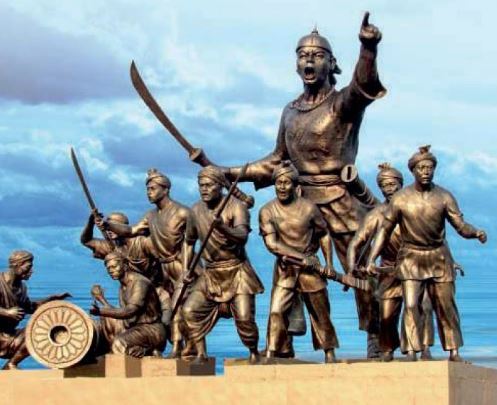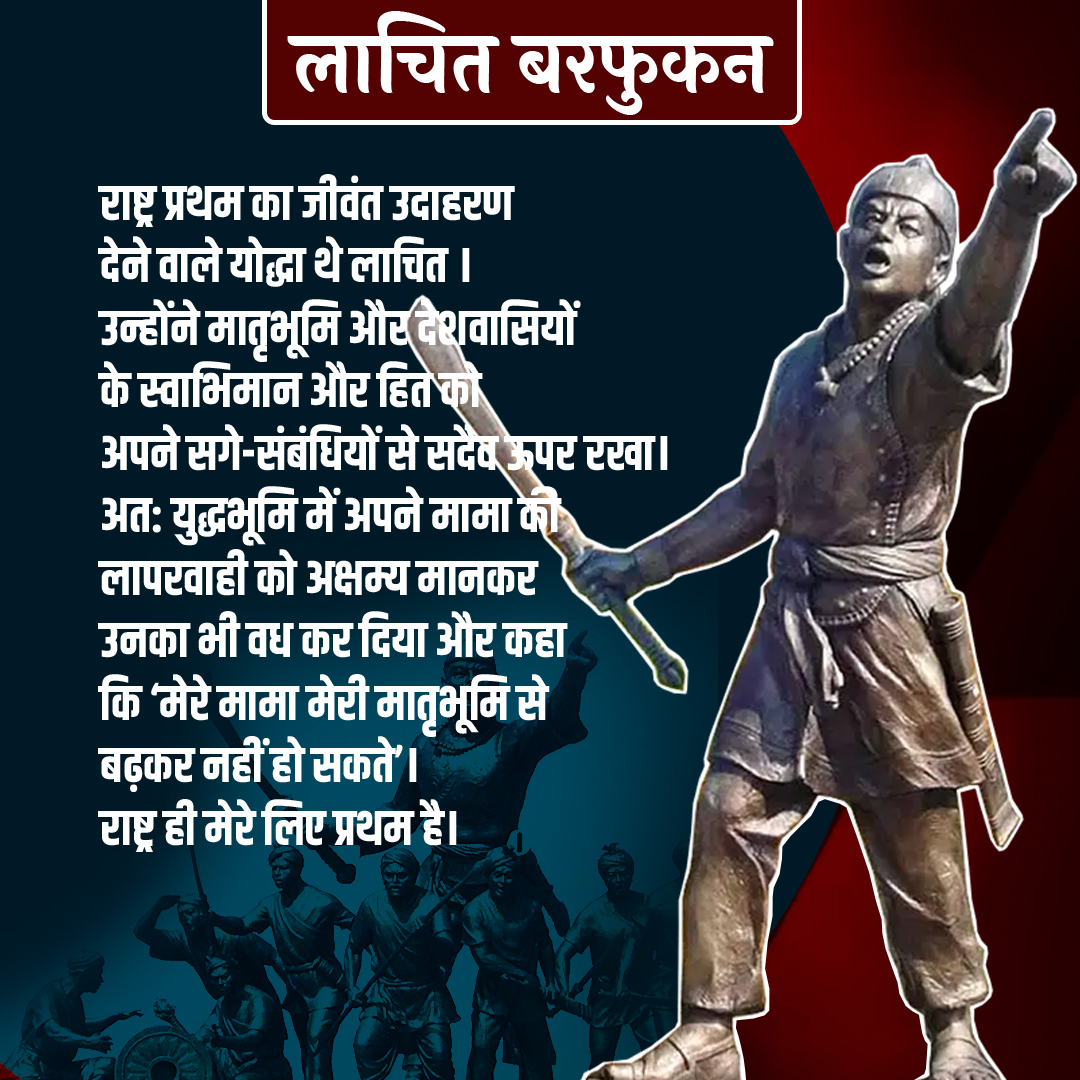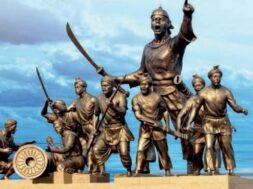
Lachit Borphukan Birth Anniversary: Effectively led his army in the battle of Saraighat in 1671
In the 17th century, the Mughal Empire was dominant across large swathes of the Indian subcontinent. Stretching from the Deccan plateau in South India to Afghanistan and Kashmir in the north, the empire also had designs on Assam which was part of the Ahom Kingdom.
Like two great warriors -Maharana Pratap and Shivaji Maharaj who are well known for taming the mighty Mughals, there was another legendary Army General (Borphukan) from Assam (Ahom Kingdom) Lachit Borphukan who halted the advance of the Mughal Empire in Assam and entire north east region and had reversed Mughal territorial gains in the region.

Lachit Borphukan died from natural causes in April 1672 about a year after the Battle of Saraighat. His remains lie in the Lachit Maidaam near Jorhat.
• Lachit Borphukan, originally named as Lachit Deka was born on 24th November, 1622 at Betioni in the Golaghat district of modern Assam
• He is known for his leadership in the Battle of Saraighat, 1671 in which an attempt by Mughal forces to capture Assam was thwarted and earlier occupied areas were recovered
• His Birthday is celebrated as Lachit Diwas by the people of Assam and the Nation
• He was the inspiration behind strengthening India’s naval force and revitalising inland water transport and creating infrastructure associated with it due to his great naval strategies.
• The Lachit Borphukan gold medal is awarded to the best cadet from the National Defence Academy.
• The medal was instituted in 1999 to inspire defence personnel to emulate Borphukan’s heroism and sacrifices.
- Ahom Kingdom:
Founder: Chaolung Sukapha was a 13th century ruler who founded the Ahom kingdom that ruled Assam for six centuries. The Ahoms ruled the land till the province was annexed to British India in 1826 with the signing of the Treaty of Yandaboo.
Political Setup: Ahoms created a new state by suppressing the older political system of the Bhuiyan (landlords).
The Ahom state depended upon contributory labour. Those who used work for the state were called paiks.
Society: Ahom society was divided into clans or khels. A khel often controlled several villages. Ahoms were Hindus and they used to worship Hindu Gods along with their own tribal gods. Intermarriage with local also increased assimilation processes of Ahoms in Assamese culture.
Art and Culture: Poets and scholars were given land grants and theatre was encouraged. Important works of Sanskrit were translated into the local language. Historical works, known as buranjis, were also written, first in the Ahom language and then in Assamese.
Military Strategy: The Ahom king was the supreme commander of the state as well as the Military. The Ahom king himself led the state forces in the time of wars. The Paiks were the main army of the state. There were two types of Paiks i.e. serving and non-serving. The non-serving Paiks constituted a standing militia which could be mobilized at a short notice by the kheldar (an expert military organizer). The full contingent of the Ahom Army consisted of infantry, navy, artillery, elephantry, cavalry and spies. The main war weapons consisted of bows and arrows, swords, Javelins discus, guns, match-locks and cannons.
The Ahoms had an advanced intelligence system and they were well versed to probe the enemy’s strength and the war strategies of the enemies. The Ahom soldiers were experts in guerilla fighting. Sometimes they allowed the enemies to enter the country, then cut off their communications and attack them in front and rear.
Few important forts: Chamdhara, Saraighat, Simlagarh, Kaliabar, Kajali and Pandu. They also learnt the technique of constructing boat bridges in the Brahmaputra. Above all, the mutual understanding among the civil and military wings, unity among the nobles always worked as strong weapons of the Ahoms and they ruled the Assam and nearby areas for the six centuries.




Biography
Lachit Borphukan (originally named Lachit Deka and acquired the ‘Borphukan’ surname after being the appointed as Ahom Kingdom’s Borphukan-Assamese word for Commander in Chief with executive as well as judicial powers ) one of the greatest warriors Assam had ever seen, their own Shivaji and Rana Pratap, was born to Momai Tamuli Borbarua, the commander-in-chief of the Ahom army on November 24, 1622 in the Betioni , Golaghat district of modern Assam. Borbarua was an office created by Pratap Singha, the Ahom king, also known as Sushengpaa, whose reign saw the expansion of the Ahom kingdom and was also regarded as a great administrator. In a sense, Pratap Singha, laid down the basic administrative structure of the Ahom rulers, which was followed after him. He was also successful in forging an alliance with Koch Hajo, the kingdom of the Koch rulers, which lay between the Sankosh and Bareli rivers. It was Pratap Singha, who created the offices of Borphukan and Borbarua, in addition to the existing offices of Burhagohain, Borgohain and Borpatrogohain. They were collectively called the 5 Patra Mantris. While Borphukan and Borbarua, respectively governed the areas, west and east of the Kaliabor River, Borgohain administered the region south of the Dikhow river, while Burhagohain, the northern side of the river. The Borpatragohain administered the region from Dafala Hills to the Brahmaputra.
Momai Tamuli started from very humble origins as a bondsman, and he was noticed by Pratap Singha, who pleased with his hard work, appointed him as the Bar Tamuli or the superintendent of Royal Gardens. His real name was Sukuti; he got his name from his position Tamuli and the fact that he was affectionately called as Momai (maternal uncle in Assamese). He rose to prominence during the Mughal wars due to his bravery and foresight, and played a crucial rule in the Treaty of Asurar Ali, so much that a Mughal envoy remarked, “If the Ahom ruler is a veritable Mahadeva, Momai Tamuli is his Nandi, and with them together, it is impossible to conquer that land”. Tamuli also played a major role in the administration and governance of the Ahom kingdom.
It was to such an illustrious man that a great son was born, Lachit Borphukan, who would rise to become one of the greatest heroes of Assam, and one of the symbols of resistance to the Mughal rule.
Before taking the role of the supreme commander of the army Borphukan held various posts of eminence such as Superintendent of the Royal Horses or Ghora Barua, Commander of the Strategic Simulgarh Fort, and Superintendent of the Royal Household Guards or Dolaksharia Barua. He was also made the scarf bearer aka Soladhara Barua of the Ahom King which is a position equivalent to a Private Secretaryship. Under the Ahom king Chakradhwaj he was finally appointed as the Commander-in-Chief of the Ahom Army.
The Battle of Saraighat for which Borphukan is popularly attributed to was fought on the banks of Brahmaputra. The Mughal army consisted of 30,000 infantry, 15,000 archers, 18,000 Turkish cavalries, 5,000 gunners, and over 1,000 canons. Borphukan knew that they would not be able to defeat these vast armies with regular warfare. Therefore, the braveheart used tactics of guerrilla warfare and wise terrain choices and led the Ahom army to a decisive victory.
The Ahom hero was also offered a bribe of one lakh to abandon his army, such was the valour and power of Borphukan.The Mughals knew that they would not stand a chance against the Ahom army if it was led by Borphukan and this was also proven in the battle.




Ahoms and Mughal Conflict
Assam was facing incessant Islamic invasion since January 1662. Aurangzeb’s maternal uncle, Governor of Bengal and Mughal General Mir Jumla II also known as Nawab Muazzam Khan attacked Ahom capital Gargaon. A portion of Ahom kingdom was lost to Mughals and its suzerainty was challenged. But Mir Jumla II couldn’t make decisive defeat over the Ahom King Jayadhwaja Singha as the king retreated to the hill and continued guerrilla warfare. His successor Chakradhwaj completely overhauled Ahom army and made Lachit Borphukan the Commander of the Ahom army in 1667.
Lachit’s first attack on Mughals
In August 1667, Lachit Borphukan, the new Commander of Ahom army, accompanied by Atan Burhgohain, proceeded to retake Guwahati from the Mughals. Lachit made Kaliabor his headquarter and Bahbari was re-taken in September 1667. He re-conquered the entire area between Guwahati and Kapili River. Thereafter, Guwahati was attacked from the river banks. Shah Buruz and Rangamahal fort were occupied. In early November of 1667, Lachit took Itakhuli in a daring midnight attack. Most of the Mughal defenders were massacred. The Ahoms took Firoz Khan, the Mughal faujdar of Guwahati, as prisoner. Brilliantly using the river front, Lachit routed the Mughals from Umananda and Barhat. Ahom king Chakradhwaj Singha gifted a gold-plated sword ‘Hengdang’ to Lachit.




The Mughals had four divisions. The first one was headed by Raja Ram Singh at the north bank of Brahmaputra. The second one was commanded by Ali Akbar Khan at the south bank. The third division at Sindhurighopa was headed by Jahir Beg and was supported by the soldiers of Koch Bihar. Naval Commander Munawar Khan was guarding the Brahmaputra approach. Ahoms were supported by Jaintias, Garos, Nagas and the soldiers of Darrang. But their biggest friend was infamous monsoon of the Brahmaputra plain. Atan Burhgohain was holding the north bank of Brahmaputra and Lachit himself commanded the Ahom force at south bank. Atan regularly harassed Mughal Army with daring guerrilla warfare. However, the Ahoms suffered a major setback at Alboi, when around ten thousand Ahom soldiers were massacred by the Mughal Army. At the same time, Raja Ram Singh tried to create doubts in the mind of Ahom Raja Chakradhwaj Singha using false propaganda against Lachit. The Ahom Army got demoralized and started retreating. The Mughal Army reached very close to the Ahom headquarter at Andharubali. Ahom soldiers retreated further to Kajali.
Lachit fell very ill and was advised to not go out in the battlefield.Amidst his absence, the Mughal started pushing the Ahom Army hard. Disregarding the serious illness, he entered the fray. He sent orders for all the land and naval forces to attack the Mughals. He himself remained in one of the seven war boats of the Ahoms. The biggest river battle of India commenced. Lachit assuming direct command of his force had a terrific impact on the Ahom soldiers. Their warships started attacking Mughal Navy from all sides. The fiercest river battle was fought near Itaguli, Kamakhya and Aswakranta. The Mughal Admiral Munawar Khan was shot dead and it totally scattered the Mughal force. Four thousand soldiers of Mughal Army were annihilated, their entire Navy was destroyed and they were thrown back to the western part of the Ahom kingdom, on the other bank of Manas river. Mughal Army was also routed at Darrang. Lachit Borphukan single-handedly led a vastly outnumbered Ahom force to victory over a numerically superior Mughal Army. The battle of Sarai Ghat was one of the most significant warfares in medieval India. This battle shattered the dream of the Mughals to expand their kingdom at the north-eastern part of India.
Lachit Divas (Lachit Day) is celebrated every year on 24th November to commemorate the heroism of Lachit Borphukan and the victory of the Assamese army at the Battle of Saraighat.He was born in 1622 at Gargaon, Assam. pic.twitter.com/o2yZHKqn6y
— Prof.(Dr.)Shirish Kashikar 🇮🇳 (@journogujarati) November 24, 2023
References
Abdul Karim (1992) History of Bengal, Mughal Period, vol I, (Rajshahi,)
Abul Fazl Allami, ‘Ain-I-Akbari’, translated from original Persian by Col. H.S. Jarrett, Published by Asiatic Society of Bengal, Vol. II. Calcutta, 1938.
Alexander Mackenzie, Northeast Frontier of India, New Delhi: Mittal Publications, 2001, first published in 1884 as ‘History of the Government with the Hill Tribes of the North-East Frontier of Bengal’.
Assam State Gazetteer, Vol.1, edited by Amlan Baruah, Government of Assam, Guwahati: 1999.
Census of India, Ministry of Home Affairs, 1951.
Duff, Grant, History of the Marhattas Oxford University Press, London,1921
Edward Gait, A History of Assam, Guwahati: EBH Publishers, 2008.
H.K. Barpujari (ed ‘Political History of Assam’, Vol.1, 1826-1919, Government of Assam, Calcutta: K.G. Pal Nabajiban Press, 1977.
Huen Tsiang, Si-Yu-Ki: Buddhist Records of the Western World, translated by Samuel Beal, Vol. I.
Jadunath Sarkar History of Bengal, II Dhaka, 1948
Majumdar, R.C. (ed.) The Mughul Empire, Mumbai: Bharatiya Vidya Bhavan, 2007
Manimugdha Sharma, ‘Lachit Barphukan: An Assamese war hero and new Hindutva icon’, Times of India, 25 November 2015.
NCERT, North East India: People, History and Culture, New Delhi: 2017.
Shihabuddin Talish, Fathiya- i ibriyya as quoted in Edward Gait, A History of Assam, Guwahati: EBH Publishers, 2013
The London Gazette: Official Public Record, London: 4 June 1946













